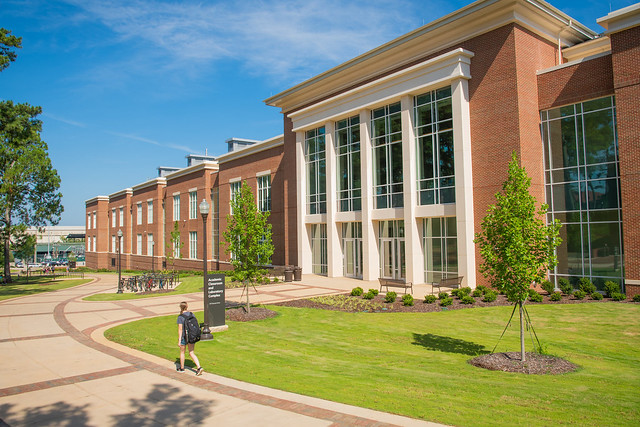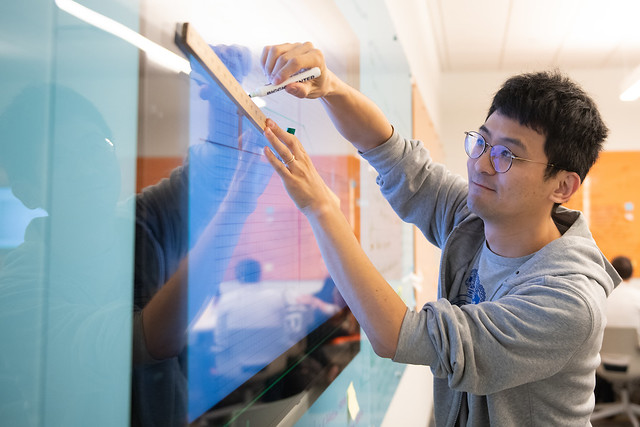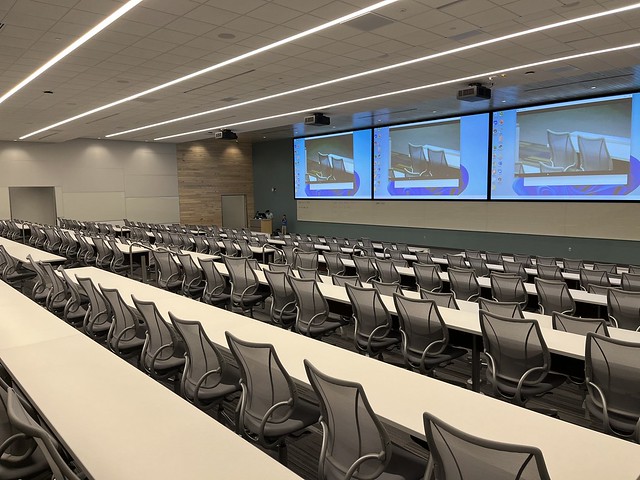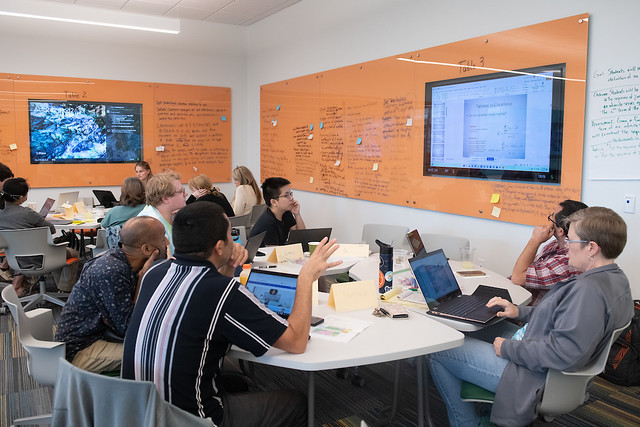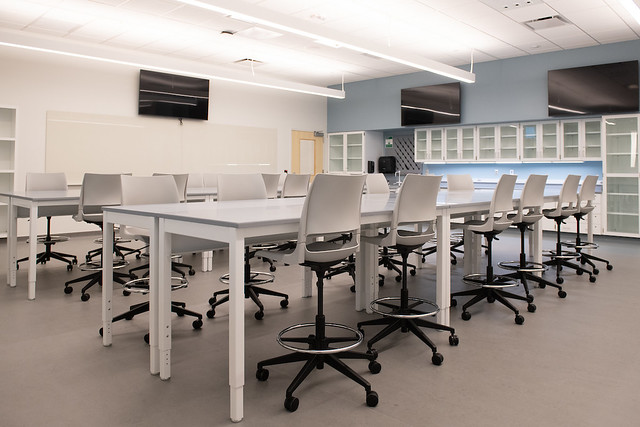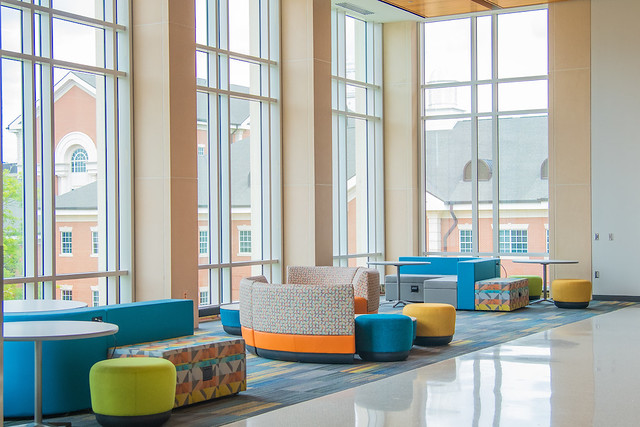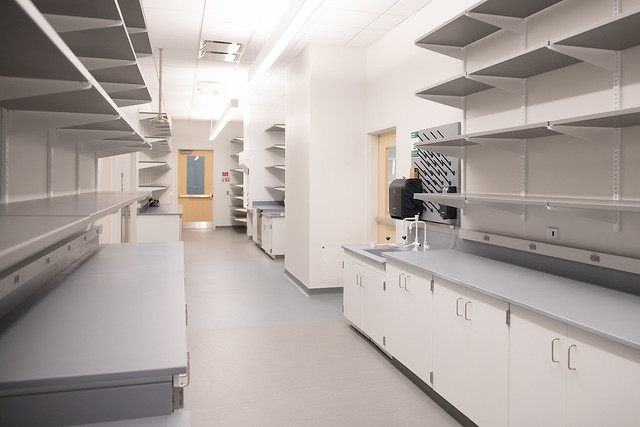Auburn University opens state-of-the-art Academic Classroom and Laboratory Complex with start of fall semester
Article body
As students returned to campus for a new academic year, thousands started the fall semester in a new facility designed to support Auburn’s commitment to elevating teaching and learning.
The Academic Classroom and Laboratory Complex, or ACLC, is a new 151,000-square-foot facility adjacent to The Edge at Central Dining and Auburn Amphitheater that features adaptable classroom spaces, labs, relaxation and study areas, lecture halls and atriums and can accommodate up to 2,000 students at a time. The building’s bottom level features a trio of spacious lecture halls with seating for 96, 200 and 300 students, respectively, and faculty will have the ability to record and broadcast their lectures utilizing the facility’s audio-visual technology.
In addition, the facility’s laboratories are equipped with numerous work stations and preparatory lab spaces that include refrigeration units, HVAC systems and safety showers. Designed as flexible teaching spaces, the rooms offer dual functionality as both laboratory or classroom instruction areas.
With more than 30 total classrooms and laboratories available, ACLC stands second to only Haley Center in total classroom space on Auburn’s more than 2,100-acre campus.
“The ACLC is a strategic investment in Auburn’s next-generation learning spaces and reflects our institution’s commitment to building for the future,” Interim Provost Vini Nathan said. “Following years of planning and development, the ACLC represents how technology and design can effectively facilitate innovation and collaboration, contributing to an exceptional experience for our students.”
ACLC primarily will be used by the College of Sciences and Mathematics, or COSAM, College of Human Sciences, College of Architecture, Design and Construction, Samuel Ginn College of Engineering and the College of Liberal Arts. The building also includes more than 12,000 square feet of space for informal learning, study and breakout work for students.
“I watched the building go up last year, and I really liked the way they designed it,” said Matthew Hill, a sophomore majoring in mechanical engineering. “I think it’s very modern. I run by here every morning, and I always look at it and am like, ‘Wow, that’s just an amazing piece of work right there.’
“I definitely think Auburn does a great job of making sure all its students are taken care of and that they all have the resources they need to succeed.”
The innovative facility also is the new home for the Biggio Center for the Enhancement of Teaching and Learning, a resource for Auburn faculty that “engages, supports and empowers the university’s academic community in each phase of the scholarly teaching transformative learning process.” Faculty members can utilize meeting and office space, relax and recharge in common areas and work with Biggio Center staff and other colleagues to share innovative teaching and learning approaches.
“The ACLC showcases Auburn’s commitment to student-centric and innovative teaching and learning,” said Asim Ali, executive director of the Biggio Center. “By embracing the unique features of the spaces, such as movable furniture, group seating, screen sharing and glass boards, our faculty are creating an engaging environment that leads to stronger learning outcomes.”
The ACLC’s design includes sustainable elements throughout the building, including more than 22,000 board feet of heritage wood harvested from 21 pine trees removed from the site. Featured on the walls and ceilings of breakout and huddle spaces throughout the building, the reclaimed wood also can be seen in the large lecture halls.
“The technology is much more updated here, and it just allows me to open many more windows that perhaps I couldn’t have before,” said Heather Haskell, a mathematics lecturer who teaches in the facility. “It allows more students to come in and gain from what Auburn has to offer.”
The three-story building is equipped with multiple elevators, is fully ADA compliant and accessible and adds an additional tornado and storm shelter to the campus. With several sustainable features, the ACLC is pursuing a certification level of silver with the Leadership in Energy and Environmental Design certification system, or LEED. The building’s construction also coincided with the transformation of Graves Drive into a pedestrian concourse that helps establish a greenway/pedway network that stretches from the Sportsplex off Lem Morrison Drive into the heart of campus.
“The ACLC is the keystone project of the Central Classroom Facility Program, which began in 2011 with the goal to qualitatively improve outdated teaching spaces on campus,” said Brad Prater, an Auburn campus architect who served as design project manager for the ACLC. “The building is the culmination of more than 10 years of work and adds to the growing body of knowledge surrounding 21st century learning and teaching facilities. Auburn’s building increases the amount of active learning classroom space on campus by 40%, reinforcing the university’s commitment to deep, engaged learning and student success.”
ACLC’s construction was overseen by Auburn Facilities Management and is part of a strategic facility initiative dating back more than a decade that included the construction of the Mell Classroom Building that is attached to the Ralph Brown Draughon Library. That initiative’s momentum will continue later this fall when the Tony and Libba Rane Culinary Science Center opens as well.
President Christopher B. Roberts and other Auburn University leaders will be on-hand for an official ACLC opening on Friday, Sept. 16, following the Auburn Board of Trustees meeting, and all members of the Auburn Family are invited to attend.
Related Media
Media interested in this story can contact Communications Director Preston Sparks at (334) 844-9999 or preston.sparks@auburn.edu.
Auburn University is a nationally ranked land grant institution recognized for its commitment to world-class scholarship, interdisciplinary research with an elite, top-tier Carnegie R1 classification, life-changing outreach with Carnegie’s Community Engagement designation and an undergraduate education experience second to none. Auburn is home to more than 30,000 students, and its faculty and research partners collaborate to develop and deliver meaningful scholarship, science and technology-based advancements that meet pressing regional, national and global needs. Auburn’s commitment to active student engagement, professional success and public/private partnership drives a growing reputation for outreach and extension that delivers broad economic, health and societal impact.



